- 12023华为OD面试手撕真题【最长的连续绿色衣服的士兵】_华为面试手撕
- 2SRC漏洞挖掘--CNVD国家信息安全漏洞共享平台
- 3VC++界面编程之--仿Facebook透明登录窗口_[main_dlg.xml] - change state to retry
- 4OpenHarmony实战:烧录Hi3516DV300开发板
- 5内存溢出的几种原因和解决方法_解决内存溢出
- 6el-upload与springboot使用_el-upload springboot
- 7Python实现飞书机器人定时发送文本、图片等群消息_飞书机器人发送图片
- 8七. 图像生成文本
- 9SQL Server 中,删除表数据有以下几种方式_sql sever删除表格中的数据
- 10基于SpringBoot+Vue高校奖助学金系统设计和实现(源码+LW+部署讲解)
Java集合之List集合_javalist集合
赞
踩
一、 List概述
1.1概念
List是一种常用的集合类型,它可以存储任意类型的对象,也可以结合泛型来存储具体的类型对象,本质上就是一个容器。
1.2体系
List中主要有ArrayList、LinkedList两个实现类
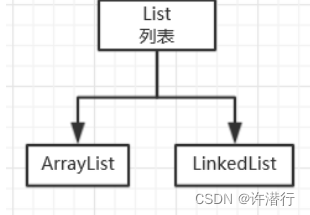
1.3 通用方法
ArrayList和LinkedList通用方法
| 方法名 | 说明 |
|---|---|
| public boolean add(要添加的元素) | 将指定的元素追加到此集合的末尾 |
| public boolean remove(要删除的元素) | 删除指定元素,返回值表示是否删除成功 |
| public E remove(int index) | 删除指定索引处的元素,返回被删除的元素 |
| public E set(int index,E element) | 修改指定索引处的元素,返回被修改的元素 |
| public E get(int index) | 返回指定索引处的元素 |
| public int size() | 返回集合中的元素的个数 |
| boolean contains(Object o) | 如果此列表包含指定的元素,则返回 true |
| boolean addAll(int index, Collection<? extends E> c) | 将指定集合中的所有元素插入到此列表中,从指定的位置开始 |
| void clear() | 列表中删除所有元素 |
这里以ArrayList举例
代码测试:
public static void main(String[] args) { // TODO Auto-generated method stub // 创建集合 List list = new ArrayList<>(); // 添加元素 list.add("hello"); list.add("world"); list.add("java"); // public boolean remove(Object o):删除指定的元素,返回删除是否成功 System.out.println(list.remove("world"));//true System.out.println(list.remove("javaee"));//false // public E remove(int index):删除指定索引处的元素,返回被删除的元素 System.out.println(list.remove(1));//world // IndexOutOfBoundsException System.out.println(list.remove(3)); // public E set(int index,E element):修改指定索引处的元素,返回被修改的元素 System.out.println(list.set(1,"javaee"));//world // IndexOutOfBoundsException System.out.println(list.set(3,"javaee")); // public E get(int index):返回指定索引处的元素 System.out.println(list.get(0));//hello System.out.println(list.get(1));//world System.out.println(list.get(2));//java // IndexOutOfBoundsException System.out.println(list.get(3)); // public int size():返回集合中的元素的个数 System.out.println(list.size());//3 // 输出集合 System.out.println("list:" + list);//list:[hello, world, java] // boolean contains(Object o) 如果此列表包含指定的元素,则返回 true System.out.println(list.contains("world"));//true // boolean addAll(int index, Collection c) //将指定集合中的所有元素插入到此列表中,从指定的位置开始 List list2 = new ArrayList<>(); //addall前list2 System.out.println(list2);// [] System.out.println(list2.addAll(0, list));// true //addall后list2 System.out.println(list2);// [hello, world, java] }
- 1
- 2
- 3
- 4
- 5
- 6
- 7
- 8
- 9
- 10
- 11
- 12
- 13
- 14
- 15
- 16
- 17
- 18
- 19
- 20
- 21
- 22
- 23
- 24
- 25
- 26
- 27
- 28
- 29
- 30
- 31
- 32
- 33
- 34
- 35
- 36
- 37
- 38
- 39
- 40
- 41
- 42
- 43
- 44
- 45
- 46
- 47
- 48
- 49
- 50
- 51
二、List的特点
(1)有序性:List中的元素是按照添加顺序进行存放的。因为有序,所以有下标,下标从0开始
(2)可重复性: List中可以存储重复的元素
三、遍历方式
3.1 foreach
List list = new ArrayList<>();
//添加元素
list.add("hello");
list.add("world");
list.add("java");
for (Object object : list) {
System.out.println(object);
}
- 1
- 2
- 3
- 4
- 5
- 6
- 7
- 8
- 9
- 10
3.2 for循环
根据下标遍历
//创建集合
List list = new ArrayList<>();
//添加元素
list.add("hello");
list.add("world");
list.add("java");
for (int i = 0; i < list.size(); i++) {
System.out.println(list.get(i));
}
- 1
- 2
- 3
- 4
- 5
- 6
- 7
- 8
- 9
- 10
- 11
3.3迭代器
//创建集合
List list = new ArrayList<>();
//添加元素
list.add("hello");
list.add("world");
list.add("java");
Iterator iterator = list.iterator();
while (iterator.hasNext()) {
System.out.println(iterator.next());
}
- 1
- 2
- 3
- 4
- 5
- 6
- 7
- 8
- 9
- 10
- 11
- 12
四、ArrayList
4.1ArrayList概述
4.1.1概念
ArrayList是Java中的一个类,实现了List接口,底层使用数组来存储元素。与数组相比,它具有更灵活的大小和动态的增加和删除元素。
4.1.2数据结构
ArrayList的数据结构本质上就是数组。区别在于,数组是一种静态的数据结构,需要在创建数组时就指定它的长度,并且创建后长度无法改变。而ArrayList是一种动态的数据结构,它可以自动进行扩容。
ArrayList的底层数据结构:

4.2ArrayList的特点
除了具备List有序性、可重复性特点外,ArrayList还具备以下的特点:
4.2.1自动扩容
当向ArrayList中加入的元素超过了其默认的长度时(由于ArrayList是数组的封装类,在创建ArrayList时不用给定长度,其默认长度为10),它会自动扩容以增加存储容量
4.2.2随机访问
随机访问是指可以直接访问元素,而不需要从头部或者尾部遍历整个列表。由于ArrayList底层是用数组实现的,因此可以通过索引来快速访问元素。
4.2.3 慢速插入/删除:
相比于链表(如LinkedList),ArrayList在中间插入或删除元素较慢,因为需要移动元素。
4.2.4高效的遍历
由于ArrayList底层采用了数组来存储元素,所以对于ArrayList的遍历操作比较高效。
4.3常用方法
| 方法名 | 说明 |
|---|---|
| trimToSize() | 将内部存储的数组大小调整为列表中元素的实际数量。 |
| ensureCapacity(int minCapacity) | 设置内部存储的数组大小,以容纳指定数量的元素。 |
| toArray(T[] a) | 将列表中的元素转换为指定类型的数组 |
代码测试:
package com.xqx.list; import java.lang.reflect.Field; import java.util.ArrayList; import java.util.List; public class demo4 { public static void main(String[] args) throws Exception { //创建一个容量为100的集合 ArrayList list = new ArrayList(100); //新增数据前容量 elementDataLength(list); //当前List集合容量为:100 for (int i = 0; i < 101; i++) { list.add(i);//增加101个元素 } //新增数据后容量大小 elementDataLength(list); //当前List集合容量为:150 list.trimToSize(); //调用trimToSize()方法后容量大小,能够避免资源浪费 elementDataLength(list); //当前List集合容量为:101 //创建一个容量为4的集合 ArrayList list2 = new ArrayList(4); elementDataLength(list2);//当前List集合容量为:4 list2.add(1); list2.add(2); list2.add(3); list2.add(4); list2.add(5); //超过4个元素自动扩容 4*1.5=6 elementDataLength(list2);//当前List集合容量为:6 //手动扩容,减少扩容次数,影响性能 list2.ensureCapacity(100); elementDataLength(list2);//当前List集合容量为:100 Integer[] arr = new Integer[list2.size()];//注意,传入的数组长度应该至少等于ArrayList的元素个数,否则将会抛出空指针异常。 for (Integer integer : arr) { System.out.println(integer);//null null null null null } list2.toArray(arr); for (Integer integer : arr) { System.out.println(integer);// 1 2 3 4 5 } } /** * 定义一个名为 "elementDataLength" 的方法,该方法用于使用反射获取 ArrayList 中存储元素的底层数组的长度并输出 * */ public static void elementDataLength(List list) throws Exception { // 使用反射获取 ArrayList 对象的成员变量 elementData Field ed = list.getClass().getDeclaredField("elementData"); ed.setAccessible(true); // 设置允许访问私有变量 Object[] o = (Object[]) ed.get(list); // 获取 ArrayList 中存储元素的底层数组对象的引用 // 输出 ArrayList 的容量信息,即底层数组的长度 System.out.println("当前List集合容量为:" + o.length); } }
- 1
- 2
- 3
- 4
- 5
- 6
- 7
- 8
- 9
- 10
- 11
- 12
- 13
- 14
- 15
- 16
- 17
- 18
- 19
- 20
- 21
- 22
- 23
- 24
- 25
- 26
- 27
- 28
- 29
- 30
- 31
- 32
- 33
- 34
- 35
- 36
- 37
- 38
- 39
- 40
- 41
- 42
- 43
- 44
- 45
- 46
- 47
- 48
- 49
- 50
- 51
- 52
- 53
- 54
- 55
- 56
- 57
- 58
- 59
- 60
- 61
- 62
- 63
4.4 增长因子论证
我们说ArrayList的底层数据结构是数组,而数组的长度是固定的,但ArrayList长度却是可变的。这里就能产生两个问题:
1、数组和ArrayList的性质都不一样,你怎么能说ArrayList的底层数据结构是数组?
2、即使你已经证明了ArrayList的底层数据结构是数组,那为什么数组的长度是固定的,但ArrayList长度却是可变的?
4.4.1证明ArrayList的底层数据结构是数组
证明第一个问题其实很简单,我们查看源代码即可:
(1):

(2):

(3):

我们一步步往上查看,可以看到有一个名为 elementData 的字段: transient Object[] elementData;
这个字段是用于存储 ArrayList 中所有元素的数组。
通过这些代码实现,我们可以看到 ArrayList 的内部实现确实是基于数组实现的。
4.4.2证明ArrayList的容量可变
证明第二个问题,跟我们ArrayList的一个特点密切相关,没错,聪明的你已经猜出来了,就是自动扩容:
在ArrayList中,每当添加一个元素时,都需要先检查当前数组容量是否足够,如果容量不足,则需要进行扩容操作。而ArrayList的扩容机制是:将原数组的长度乘以一个增长因子,通常是1.5,生成一个新的大数组,然后将原数组中的元素复制到新数组中来,这样就完成了扩容操作。
代码证明:
public static void main(String[] args) throws Exception { List list = new ArrayList(); for (int i = 0; i < 100; i++) { System.out.print(i + "=="); list.add(i); elementDataLength(list); // 调用 elementDataLength 方法输出当前容量 } } /** * 定义一个名为 "elementDataLength" 的方法,该方法用于使用反射获取 ArrayList 中存储元素的底层数组的长度并输出 * */ public static void elementDataLength(List list) throws Exception { // 使用反射获取 ArrayList 对象的成员变量 elementData Field ed = list.getClass().getDeclaredField("elementData"); ed.setAccessible(true); // 设置允许访问私有变量 Object[] o = (Object[]) ed.get(list); // 获取 ArrayList 中存储元素的底层数组对象的引用 // 输出 ArrayList 的容量信息,即底层数组的长度 System.out.println("当前List集合容量为:" + o.length); } //输出的内容: 0==当前List集合容量为:10 1==当前List集合容量为:10 2==当前List集合容量为:10 3==当前List集合容量为:10 4==当前List集合容量为:10 5==当前List集合容量为:10 6==当前List集合容量为:10 7==当前List集合容量为:10 8==当前List集合容量为:10 9==当前List集合容量为:10 10==当前List集合容量为:15 11==当前List集合容量为:15 12==当前List集合容量为:15 13==当前List集合容量为:15 14==当前List集合容量为:15 15==当前List集合容量为:22 16==当前List集合容量为:22 17==当前List集合容量为:22 18==当前List集合容量为:22 19==当前List集合容量为:22 20==当前List集合容量为:22 21==当前List集合容量为:22 22==当前List集合容量为:33 23==当前List集合容量为:33 24==当前List集合容量为:33 25==当前List集合容量为:33 26==当前List集合容量为:33 27==当前List集合容量为:33 28==当前List集合容量为:33 29==当前List集合容量为:33 30==当前List集合容量为:33 31==当前List集合容量为:33 32==当前List集合容量为:33 33==当前List集合容量为:49 34==当前List集合容量为:49 35==当前List集合容量为:49 36==当前List集合容量为:49 37==当前List集合容量为:49 38==当前List集合容量为:49 39==当前List集合容量为:49 40==当前List集合容量为:49 41==当前List集合容量为:49 42==当前List集合容量为:49 43==当前List集合容量为:49 44==当前List集合容量为:49 45==当前List集合容量为:49 46==当前List集合容量为:49 47==当前List集合容量为:49 48==当前List集合容量为:49 49==当前List集合容量为:73 50==当前List集合容量为:73 51==当前List集合容量为:73 52==当前List集合容量为:73 53==当前List集合容量为:73 54==当前List集合容量为:73 55==当前List集合容量为:73 56==当前List集合容量为:73 57==当前List集合容量为:73 58==当前List集合容量为:73 59==当前List集合容量为:73 60==当前List集合容量为:73 61==当前List集合容量为:73 62==当前List集合容量为:73 63==当前List集合容量为:73 64==当前List集合容量为:73 65==当前List集合容量为:73 66==当前List集合容量为:73 67==当前List集合容量为:73 68==当前List集合容量为:73 69==当前List集合容量为:73 70==当前List集合容量为:73 71==当前List集合容量为:73 72==当前List集合容量为:73 73==当前List集合容量为:109 74==当前List集合容量为:109 75==当前List集合容量为:109 76==当前List集合容量为:109 77==当前List集合容量为:109 78==当前List集合容量为:109 79==当前List集合容量为:109 80==当前List集合容量为:109 81==当前List集合容量为:109 82==当前List集合容量为:109 83==当前List集合容量为:109 84==当前List集合容量为:109 85==当前List集合容量为:109 86==当前List集合容量为:109 87==当前List集合容量为:109 88==当前List集合容量为:109 89==当前List集合容量为:109 90==当前List集合容量为:109 91==当前List集合容量为:109 92==当前List集合容量为:109 93==当前List集合容量为:109 94==当前List集合容量为:109 95==当前List集合容量为:109 96==当前List集合容量为:109 97==当前List集合容量为:109 98==当前List集合容量为:109 99==当前List集合容量为:109
- 1
- 2
- 3
- 4
- 5
- 6
- 7
- 8
- 9
- 10
- 11
- 12
- 13
- 14
- 15
- 16
- 17
- 18
- 19
- 20
- 21
- 22
- 23
- 24
- 25
- 26
- 27
- 28
- 29
- 30
- 31
- 32
- 33
- 34
- 35
- 36
- 37
- 38
- 39
- 40
- 41
- 42
- 43
- 44
- 45
- 46
- 47
- 48
- 49
- 50
- 51
- 52
- 53
- 54
- 55
- 56
- 57
- 58
- 59
- 60
- 61
- 62
- 63
- 64
- 65
- 66
- 67
- 68
- 69
- 70
- 71
- 72
- 73
- 74
- 75
- 76
- 77
- 78
- 79
- 80
- 81
- 82
- 83
- 84
- 85
- 86
- 87
- 88
- 89
- 90
- 91
- 92
- 93
- 94
- 95
- 96
- 97
- 98
- 99
- 100
- 101
- 102
- 103
- 104
- 105
- 106
- 107
- 108
- 109
- 110
- 111
- 112
- 113
- 114
- 115
- 116
- 117
- 118
- 119
- 120
- 121
- 122
- 123
- 124
我们可以看到内部容量不足时,ArrayList会将原数组长度乘以1.5进行扩容。
注意,由于 ArrayList 底层使用的是数组,因此一旦创建了 ArrayList,它的大小就是固定的。而当元素添加到 ArrayList 中时,如果底层数组已满,则需要创建一个更大的数组,并将原有元素复制到新数组中,这会带来一定的性能损耗。
因此,在实际开发中,建议在创建 ArrayList 时设置一个合适的初始化容量,避免在运行时频繁进行扩容操作,同时也可避免浪费过多空间资源。
拿以上例子稍作修改,将ArrayList容量改为50:
public static void main(String[] args) throws Exception { List list = new ArrayList(50); for (int i = 0; i < 100; i++) { System.out.print(i + "=="); list.add(i); elementDataLength(list); // 调用 elementDataLength 方法输出当前容量 } } /** * 定义一个名为 "elementDataLength" 的方法,该方法用于使用反射获取 ArrayList 中存储元素的底层数组的长度并输出 * */ public static void elementDataLength(List list) throws Exception { // 使用反射获取 ArrayList 对象的成员变量 elementData Field ed = list.getClass().getDeclaredField("elementData"); ed.setAccessible(true); // 设置允许访问私有变量 Object[] o = (Object[]) ed.get(list); // 获取 ArrayList 中存储元素的底层数组对象的引用 // 输出 ArrayList 的容量信息,即底层数组的长度 System.out.println("当前List集合容量为:" + o.length); } //输出的内容: 0==当前List集合容量为:50 1==当前List集合容量为:50 2==当前List集合容量为:50 3==当前List集合容量为:50 4==当前List集合容量为:50 5==当前List集合容量为:50 6==当前List集合容量为:50 7==当前List集合容量为:50 8==当前List集合容量为:50 9==当前List集合容量为:50 10==当前List集合容量为:50 11==当前List集合容量为:50 12==当前List集合容量为:50 13==当前List集合容量为:50 14==当前List集合容量为:50 15==当前List集合容量为:50 16==当前List集合容量为:50 17==当前List集合容量为:50 18==当前List集合容量为:50 19==当前List集合容量为:50 20==当前List集合容量为:50 21==当前List集合容量为:50 22==当前List集合容量为:50 23==当前List集合容量为:50 24==当前List集合容量为:50 25==当前List集合容量为:50 26==当前List集合容量为:50 27==当前List集合容量为:50 28==当前List集合容量为:50 29==当前List集合容量为:50 30==当前List集合容量为:50 31==当前List集合容量为:50 32==当前List集合容量为:50 33==当前List集合容量为:50 34==当前List集合容量为:50 35==当前List集合容量为:50 36==当前List集合容量为:50 37==当前List集合容量为:50 38==当前List集合容量为:50 39==当前List集合容量为:50 40==当前List集合容量为:50 41==当前List集合容量为:50 42==当前List集合容量为:50 43==当前List集合容量为:50 44==当前List集合容量为:50 45==当前List集合容量为:50 46==当前List集合容量为:50 47==当前List集合容量为:50 48==当前List集合容量为:50 49==当前List集合容量为:50 50==当前List集合容量为:75 51==当前List集合容量为:75 52==当前List集合容量为:75 53==当前List集合容量为:75 54==当前List集合容量为:75 55==当前List集合容量为:75 56==当前List集合容量为:75 57==当前List集合容量为:75 58==当前List集合容量为:75 59==当前List集合容量为:75 60==当前List集合容量为:75 61==当前List集合容量为:75 62==当前List集合容量为:75 63==当前List集合容量为:75 64==当前List集合容量为:75 65==当前List集合容量为:75 66==当前List集合容量为:75 67==当前List集合容量为:75 68==当前List集合容量为:75 69==当前List集合容量为:75 70==当前List集合容量为:75 71==当前List集合容量为:75 72==当前List集合容量为:75 73==当前List集合容量为:75 74==当前List集合容量为:75 75==当前List集合容量为:112 76==当前List集合容量为:112 77==当前List集合容量为:112 78==当前List集合容量为:112 79==当前List集合容量为:112 80==当前List集合容量为:112 81==当前List集合容量为:112 82==当前List集合容量为:112 83==当前List集合容量为:112 84==当前List集合容量为:112 85==当前List集合容量为:112 86==当前List集合容量为:112 87==当前List集合容量为:112 88==当前List集合容量为:112 89==当前List集合容量为:112 90==当前List集合容量为:112 91==当前List集合容量为:112 92==当前List集合容量为:112 93==当前List集合容量为:112 94==当前List集合容量为:112 95==当前List集合容量为:112 96==当前List集合容量为:112 97==当前List集合容量为:112 98==当前List集合容量为:112 99==当前List集合容量为:112
- 1
- 2
- 3
- 4
- 5
- 6
- 7
- 8
- 9
- 10
- 11
- 12
- 13
- 14
- 15
- 16
- 17
- 18
- 19
- 20
- 21
- 22
- 23
- 24
- 25
- 26
- 27
- 28
- 29
- 30
- 31
- 32
- 33
- 34
- 35
- 36
- 37
- 38
- 39
- 40
- 41
- 42
- 43
- 44
- 45
- 46
- 47
- 48
- 49
- 50
- 51
- 52
- 53
- 54
- 55
- 56
- 57
- 58
- 59
- 60
- 61
- 62
- 63
- 64
- 65
- 66
- 67
- 68
- 69
- 70
- 71
- 72
- 73
- 74
- 75
- 76
- 77
- 78
- 79
- 80
- 81
- 82
- 83
- 84
- 85
- 86
- 87
- 88
- 89
- 90
- 91
- 92
- 93
- 94
- 95
- 96
- 97
- 98
- 99
- 100
- 101
- 102
- 103
- 104
- 105
- 106
- 107
- 108
- 109
- 110
- 111
- 112
- 113
- 114
- 115
- 116
- 117
- 118
- 119
- 120
- 121
- 122
- 123
我们可以看到这次只扩容了两次,从50-75、从75-112,这大大减少了性能损耗,所以在创建 ArrayList 时设置一个合适的初始化容量是非常重要的。
4.5 ArrayList去重
4.5.1字符串去重
使用contains方法
public static void main(String[] args) {
List list = new ArrayList();
list.add("a");
list.add("b");
list.add("c");
System.out.println("目前集合容器中的元素:"+list);//目前集合容器中的元素:[a, b, c]
if (!list.contains("b")){//如果不包含“b”
list.add("b");//才增加
}
System.out.println("目前集合容器中的元素:"+list);//目前集合容器中的元素:[a, b, c]
}
}
- 1
- 2
- 3
- 4
- 5
- 6
- 7
- 8
- 9
- 10
- 11
- 12
4.5.2对象去重
public static void main(String[] args) { List list = new ArrayList(); list.add(new Student("zs",16)); list.add(new Student("ls",17)); list.add(new Student("ww",18)); System.out.println("目前集合容器中的元素:"+list); //目前集合容器中的元素:[com.xqx.demo.Student@33909752, com.xqx.demo.Student@55f96302, com.xqx.demo.Student@3d4eac69] if (!list.contains(new Student("ls",17))){//不包含才新增 list.add(new Student("ls",17)); } System.out.println("目前集合容器中的元素:"+list); //目前集合容器中的元素:[com.xqx.demo.Student@33909752, com.xqx.demo.Student@55f96302, com.xqx.demo.Student@3d4eac69, com.xqx.demo.Student@42a57993] if (list.contains(new Student("ls",17))){//包含才移除 list.remove(new Student("ls",17)); } System.out.println("目前集合容器中的元素:"+list); //目前集合容器中的元素:[com.xqx.demo.Student@33909752, com.xqx.demo.Student@55f96302, com.xqx.demo.Student@3d4eac69, com.xqx.demo.Student@42a57993] } } class Student{ private String name; private int age; public Student(String name, int age) { this.name = name; this.age = age; } public String getName() { return name; } public void setName(String name) { this.name = name; } public int getAge() { return age; } public void setAge(int age) { this.age = age; }
- 1
- 2
- 3
- 4
- 5
- 6
- 7
- 8
- 9
- 10
- 11
- 12
- 13
- 14
- 15
- 16
- 17
- 18
- 19
- 20
- 21
- 22
- 23
- 24
- 25
- 26
- 27
- 28
- 29
- 30
- 31
- 32
- 33
- 34
- 35
- 36
- 37
- 38
- 39
- 40
- 41
- 42
- 43
- 44
- 45
为什么 student(‘ls’,17) 并没有新增与移除?
由于在 Java 中,比较对象是否相等是基于对象的地址进行的,而不是基于对象的属性值进行的。而实例化后,会新开一个地址。所以即使两个student的属性值相等,但实例化后地址不同,那么这两个对象就也不是相等的。
解决方案
重写equals方法即可
public static void main(String[] args) { List list = new ArrayList(); list.add(new Student("zs",16)); list.add(new Student("ls",17)); list.add(new Student("ww",18)); System.out.println("目前集合容器中的元素:"+list); //目前集合容器中的元素:[com.xqx.demo.Student@33909752, com.xqx.demo.Student@55f96302, com.xqx.demo.Student@3d4eac69] if (!list.contains(new Student("ls",17))){//不包含才新增 list.add(new Student("ls",17)); } System.out.println("目前集合容器中的元素:"+list); //目前集合容器中的元素:[com.xqx.demo.Student@33909752, com.xqx.demo.Student@55f96302, com.xqx.demo.Student@3d4eac69] if (list.contains(new Student("ls",17))){//包含才移除 list.remove(new Student("ls",17)); } System.out.println("目前集合容器中的元素:"+list); //目前集合容器中的元素:[com.xqx.demo.Student@33909752, com.xqx.demo.Student@3d4eac69] } } class Student{ private String name; private int age; public Student(String name, int age) { this.name = name; this.age = age; } public String getName() { return name; } public void setName(String name) { this.name = name; } public int getAge() { return age; } public void setAge(int age) { this.age = age; } @Override public boolean equals(Object o) { System.out.println("调用了equals方法。。。"); if (this == o) return true; if (o == null || getClass() != o.getClass()) return false; Student student = (Student) o; return age == student.age && name.equals(student.name); }
- 1
- 2
- 3
- 4
- 5
- 6
- 7
- 8
- 9
- 10
- 11
- 12
- 13
- 14
- 15
- 16
- 17
- 18
- 19
- 20
- 21
- 22
- 23
- 24
- 25
- 26
- 27
- 28
- 29
- 30
- 31
- 32
- 33
- 34
- 35
- 36
- 37
- 38
- 39
- 40
- 41
- 42
- 43
- 44
- 45
- 46
- 47
- 48
- 49
- 50
- 51
- 52
- 53
在重写的equals方法中,我们定义了只有姓名和年龄都相同时,才认为两个学生相等。因此,当通过新建一个Student对象来判断是否存在于ArrayList中时,即使该对象的内存地址不同,只要该对象的姓名和年龄与列表中某个元素的姓名和年龄相等,就会被视为存在于ArrayList中,从而避免了重复添加元素。而在删除元素时,由于通过该对象的equals方法判断该对象是否在ArrayList中存在,因此也可以正常进行删除。
总结
Java中的引用类型在判断相等性时,是根据对象在内存中的地址进行比较的。如果不重写equals方法,那么,由于ArrayList中存储的是对象的引用,所以相当于比较的是每个对象在内存中的地址是否相同,只有两个对象的地址相同时才会被视为相等。而我们通常认为,只有两个对象的属性值相同时才能被视为相等。因此,我们需要根据对象的实际比较规则重写equals方法。
五、LinkedList
5.1 LinkedList概述
5.1.1概念
LinkedList也是Java中的一个常用的集合类,实现了List接口,底层使用的是双向链表数据结构。
与ArrayList不同,LinkedList在内部存储元素时,不是使用连续的内存空间,而是使用一个链表来存储元素。
5.1.2数据结构
LinkedList底层采用的是双向链表(doubly linked list) 数据结构。链表中的每个节点(结点)都由两个部分组成,一部分是存储数据元素的值域,另一部分是指向前一个节点和后一个节点的指针(引用)。对于双向链表来说,除了一个指向前一个节点的指针外,还有一个指向后一个节点的指针
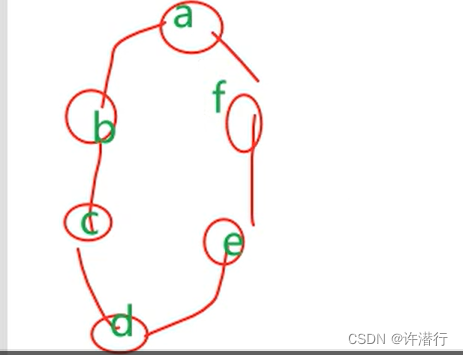
5.2LinkedList的特点
5.2.1随机访问性能较差:
LinkedList的随机访问性能较差,因为在链表中要从头开始遍历链表,直到找到目标元素。所以如果在代码中需要频繁进行随机访问元素的操作,LinkedList可能不是一个最佳的选择。
5.2.2添加/删除操作快:
由于LinkedList底层使用双向链表,因此它的添加和删除操作非常快,因为只需要更改指针的指向即可,不需要像ArrayList一样重新分配数组空间,而且LinkedList还支持在指定位置插入和删除元素。
5.2.3需要额外空间:
链表中每个节点都需要额外存储到前一个和后一个节点的指针,因此比数组等其他数据结构需要更多的内存空间。
5.2.4适用于队列和双端队列:
LinkedList还可以支持队列和双端队列的功能,如在链表头部或尾部添加或删除元素,实现队列和双端队列的常见操作。
- 双端队列(Deque,即Double Ended Queue的缩写)是一种允许在队列的两端进行插入和删除操作的数据结构。双端队列可以从队列的头部和尾部添加和移除元素。
5.3常用方法
| 方法名 | 说明 |
|---|---|
| addFirst(E element) | 将元素添加到列表的开头 |
| getFirst(): | 返回列表的第一个元素。 |
| getLast(): | 返回列表的最后一个元素。 |
| removeFirst(): | 删除并返回列表的第一个元素。 |
| removeLast(): | 删除并返回列表的最后一个元素。 |
5.4堆栈和队列
5.4.1堆栈
堆栈(Stack)是一种具有后进先出特性的数据结构。在堆栈结构中,新的元素总是被添加到栈顶(也就是最新元素),而只有在栈顶的元素才可以被移除。
堆栈最典型的例子是计算器的运算操作,先输入的操作数最后被计算,而最后输入的操作数最先被计算。对于堆栈结构,我们可以在程序中使用push(添加)和pop(移除)方法来实现后进先出的存储和读取数据。
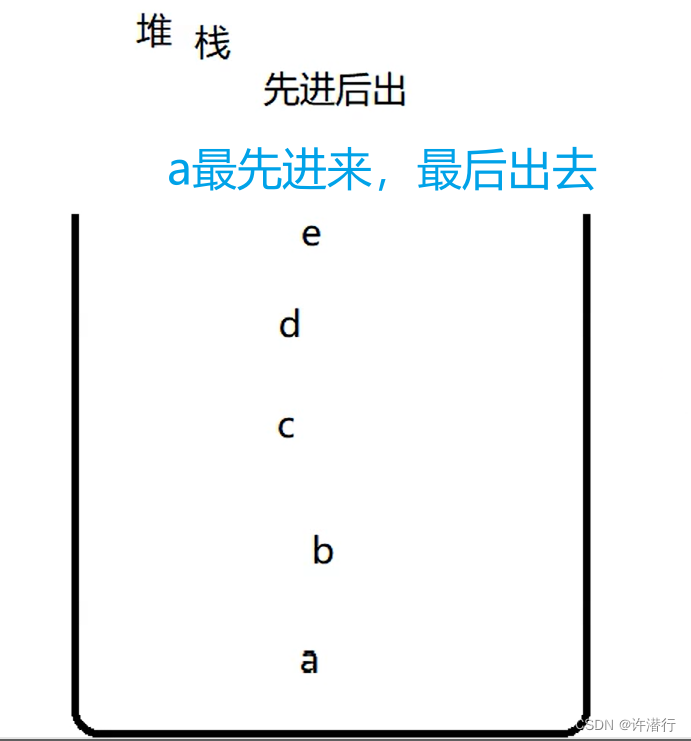
5.4.2队列
队列(Queue)是一种具有先进先出特性的数据结构。在队列结构中,新的元素总是从队列的末尾添加到队列中,然后从队列的开头进行访问或删除。
队列最典型的例子是排队。排队的人总是按先来后到的顺序排队,当前面的人离开队列之后,后面的人才能够进入。对于队列结构,我们可以使用offer()方法将新的元素添加到队尾,使用poll()方法从队列开头移除元素。
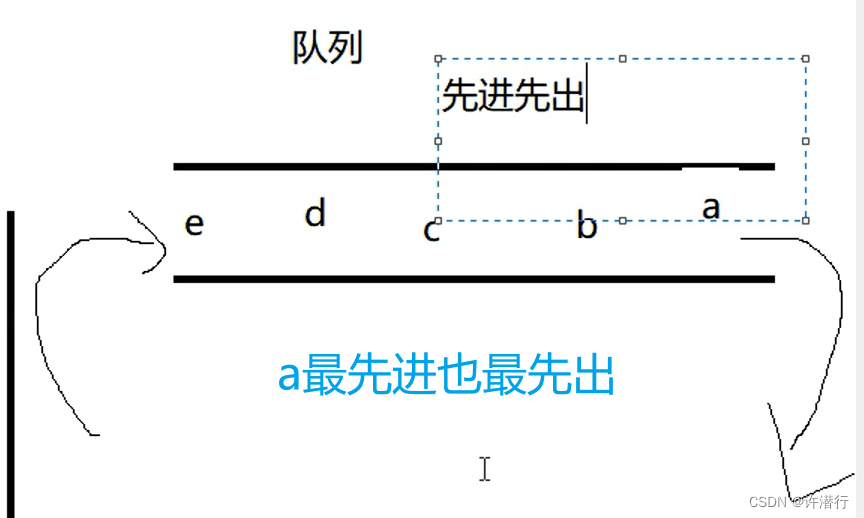
5.5常见面试题:用LinkedList完成一个堆栈容器
package com.xqx.demo; import java.util.LinkedList; public class demo3 { public static void main(String[] args) { //创建集合 LinkedList ll = new LinkedList(); //添加元素 ll.add("lisi"); ll.add("zs"); ll.add("ww"); //实例化堆栈 DuiZhan DuiZhan = new DuiZhan(ll); System.out.println(DuiZhan.pop()); System.out.println(DuiZhan.pop()); System.out.println(DuiZhan.pop()); } } class DuiZhan{ LinkedList ll = null; public DuiZhan(LinkedList ll){// 堆栈的构造函数,接受一个 LinkedList 对象作为参数,用于存储堆栈元素 this.ll = ll; } //压栈 public void add(String a){ ll.add(a); } //弹栈 public String pop(){ return (String) ll.removeLast(); 从链表末尾移除一个元素并返回其值 } }
- 1
- 2
- 3
- 4
- 5
- 6
- 7
- 8
- 9
- 10
- 11
- 12
- 13
- 14
- 15
- 16
- 17
- 18
- 19
- 20
- 21
- 22
- 23
- 24
- 25
- 26
- 27
- 28
- 29
- 30
- 31
- 32
- 33
- 34
- 35
- 36
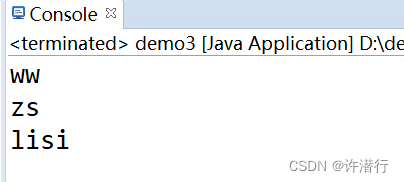
考察核心:
- 考察LinkedList的api方法
- 考察堆栈/队列的数据结构特点
六、ArrayList和LinkedList的比较
- 由于ArrayList的数据结构为数组,所以查询修改快,新增删除慢;而LinkedList的数据结构为链表结构,所以查询修改慢,新增删除快
- ArrayList是基于数组实现的动态数组,在内存中有连续的空间,可以通过下标访问元素,由于数组需要提前分配一定大小的空间,因此当元素数量增多之后,可能会导致数组空间不足需要重新分配数组,这种情况下可能会出现内存空间浪费;相比之下,LinkedList是基于链表实现的,每个元素都有一个引用指向下一个元素,不需要提前分配空间,因此能够更加灵活地插入和删除元素。然而,链表在内存中是不连续的,每个元素的引用占用额外的内存空间。由于链表中每个元素都需要有一个指向下一个元素的引用,因此在存储同样数量的元素时,LinkedList通常会占用比ArrayList更大的内存空间。
好啦,今天的分享就到此为止!希望你看完本篇文章有所收获,祝你变得更强!!!



